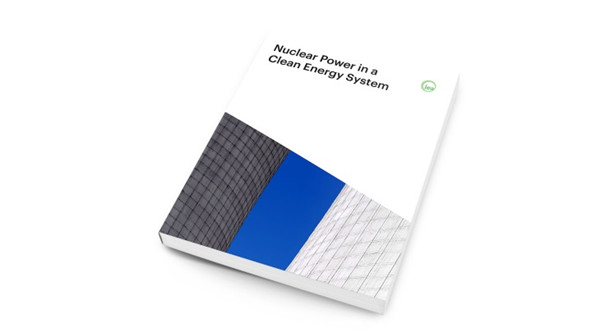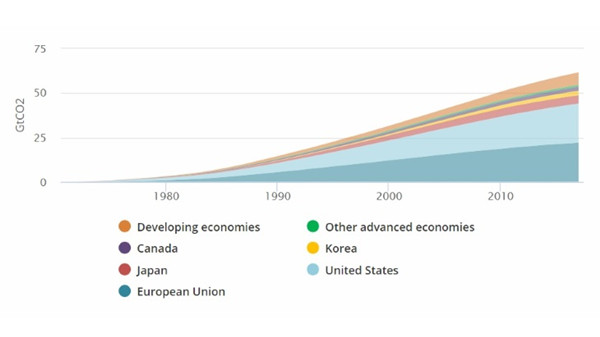The International Energy Agency (IEA) has made policy recommendations for the many countries that see a role for nuclear power in their energy transitions in a new report it plans to discuss today at the 10th Clean Energy Ministerial (CEM10) being held this week in Vancouver, Canada. Nuclear Power in a Clean Energy System is the Paris-based agency's first report addressing nuclear power in nearly two decades in order to "bring this important topic back into the global energy debate", it said.

World Nuclear Association concurred with the report's assertion that strong policy support is needed to secure investment in existing and new nuclear plants, stressing that the focus should be on designing electricity markets in a way that values the clean energy and energy security attributes of low-carbon technologies, including nuclear power.
IEA Executive Director Fatih Birol said: "Without an important contribution from nuclear power, the global energy transition will be that much harder. Alongside renewables, energy efficiency and other innovative technologies, nuclear can make a significant contribution to achieving sustainable energy goals and enhancing energy security. But unless the barriers it faces are overcome, its role will soon be on a steep decline worldwide, particularly in the United States, Europe and Japan."
Emissions reduction
Nuclear power has helped to slow the long-term increase in emissions of carbon dioxide (CO2) over the last half-century, particularly in advanced economies, the report notes. Globally, nuclear power output avoided 63 gigatonnes of CO2 from 1971 to 2018. Without nuclear power, emissions from electricity generation would have been almost 20% higher, and total energy-related emissions 6% higher, over that period. Nuclear power has provided around one-half of all low-carbon electricity in advanced economies - a total of 76,000 TWh, which is more than ten times the total output of wind and solar combined.

Cumulative CO2 emissions avoided by global nuclear power, 1971-2017 (Image: IEA)
Achieving the pace of CO2 emissions reductions in line with the Paris Agreement is already a huge challenge, the report says, as shown in the Sustainable Development Scenario. It requires large increases in efficiency and renewables investment, as well as an increase in nuclear power. It identifies the "even greater challenges" of attempting to follow this path with much less nuclear power.
Nuclear is the second-largest low-carbon power source in the world today, accounting for 10% of global electricity generation. It is second only to hydropower at 16%. For advanced economies - including the USA, Canada, the European Union and Japan - nuclear has been the biggest low-carbon source of electricity for more than 30 years and remains so today, the report says. It plays an important role in electricity security in several countries, it adds, but its future is uncertain as ageing plants are beginning to close in advanced economies - partly because of policies to phase them out, but also as a result of economic and regulatory factors.
Without policy changes, advanced economies could lose 25% of their nuclear capacity by 2025 and as much as two-thirds of it by 2040, the report says. The lack of further lifetime extensions of existing nuclear plants and new projects could result in an additional 4 billion tonnes of CO2 emissions, it adds.
Cost competitive
The report finds that extending the operational life of existing nuclear plants requires substantial capital investment, but its cost is competitive with other electricity generation technologies, including new solar and wind projects, and can lead to a more secure, less disruptive energy transition.
Market conditions remain unfavourable, however, for lengthening the lifetimes of nuclear plants. An extended period of low wholesale electricity prices in most advanced economies has sharply reduced or eliminated profit margins for many technologies, putting nuclear plants at risk of shutting down early. In the USA, for example, some 90 reactors have 60-year operating licences, yet several have already retired early and many more are at risk, the report says. In Europe, Japan and other advanced economies, extensions of plants' lifetimes also face uncertain prospects, it adds.
Investment in new nuclear projects in advanced economies is even more difficult, it says. New projects planned in Finland, France and the USA are not yet in service and have faced major cost overruns. Korea has been an important exception, it says, with a record of completing construction of new projects on time and on budget, though government policy aims to end new nuclear construction.
A sharp decline in nuclear power capacity in advanced economies would have major implications, the report warns, because without additional lifetime extensions and new builds, achieving key sustainable energy goals, including international climate targets, would become more difficult and expensive.
"If other low-carbon sources, namely wind and solar PV, are to fill the shortfall in nuclear, their deployment would have to accelerate to an unprecedented level. In the past 20 years, wind and solar PV capacity has increased by about 580 gigawatts in advanced economies. But over the next 20 years, nearly five times that amount would need to be added," the report says. "Such a drastic increase in renewable power generation would create serious challenges in integrating the new sources into the broader energy system. Clean energy transitions in advanced economies would also require USD1.6 trillion in additional investment over the same period, which would end up hurting consumers through higher electricity bills."
Role of policy makers
"Policy makers hold the key to nuclear power’s future," Birol said. "Electricity market design must value the environmental and energy security attributes of nuclear power and other clean energy sources. Governments should recognise the cost-competitiveness of safely extending the lifetimes of existing nuclear plants."
As governments and industry address these challenges, the IEA says it is ready to provide support with data, analysis and "real-world solutions".
The nuclear industry welcomed the report, agreeing that without action to provide more support for nuclear power, global efforts to transition to a cleaner energy system will become drastically harder and more costly. World Nuclear Association said the report makes clear that failure to invest in existing and new nuclear plants in advanced economies would have implications for emissions, costs and energy security.
Speaking from CEM10, Agneta Rising, director general of the London-based organisation, said more and more governments and institutions are realising the benefits of nuclear energy and including it in their plans for a sustainable and clean energy future.
"Nuclear energy is growing strongly in countries such as China and Russia, and several countries are developing new build programmes, such as Turkey, the UAE, Bangladesh, Egypt and Belarus," Rising said. "But much more will be needed to achieve the target of supplying at least 25% of global electricity demand with nuclear energy by 2050 as required by the nuclear industry's Harmony goal or even the near six-fold increase required by the International Panel on Climate Change's 'middle of the road' scenario. We welcome the IEA report's recommendation for more government interventions to secure investment in new nuclear plants."
Policy recommendations
The IEA report gives eight policy recommendations.
Keep the option open: Authorise lifetime extensions of existing nuclear plants for as long as safely possible.
Value dispatchability: Design the electricity market in a way that properly values the system services needed to maintain electricity security, including capacity availability and frequency control services. Make sure that the providers of these services, including nuclear power plants, are compensated in a competitive and non-discriminatory manner.
Value non-market benefits: Establish a level playing field for nuclear power with other low-carbon energy sources in recognition of its environmental and energy security benefits and remunerate it accordingly.
Update safety regulations: Where necessary, update safety regulations in order to ensure the continued safe operation of nuclear plants. Where technically possible, this should include allowing flexible operation of nuclear power plants to supply ancillary services.
Create an attractive financing framework: Set up risk management and financing frameworks that can help mobilise capital for new and existing plants at an acceptable cost, taking the risk profile and long time horizons of nuclear projects into consideration.
Support new construction: Ensure that licensing processes do not lead to project delays and cost increases that are not justified by safety requirements. Support standardisation and enable learning-by-doing across the industry.
Support innovative new reactor designs: Accelerate innovation in new reactor designs, such as small modular reactors (SMRs), with lower capital costs and shorter lead times and technologies that improve the operating flexibility of nuclear power plants to facilitate the integration of growing wind and solar capacity into the electricity system.
Maintain human capital: Protect and develop the human capital and project management capabilities in nuclear engineering.